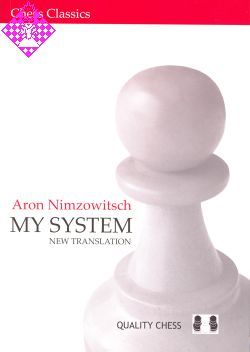Artikelnummer
LMNIMMSEQC
Autor
My System
316 Seiten, kartoniert, Quality, 2006
Aus der Reihe »Chess Classics«
Aron Nimzowitsch was one of the greatest chess players of the 1920s and 1930s, ranked just behind the famous World Champions Alekhine and Capablanca. His reputation as an author is higher still.
My System is at the top of a very short list of chess classics. Nimzowitsch's ideas have had a profound influence on modern chess thinking. Most chess masters will at some point have studied Nimzowitsch's work, and not to have read My System is by many regarded as a shocking gap in a chess player's education.
The problem for an English-speaking audience has been that My System was written in German more than eighty years ago. The commonly-used contemporary translations have sounded dated for some time, and were always questionable: the translators frequently toned down many passages, fearing Nimzowitsch's biting wit would be too controversial.
This edition uses a brand-new translation that recreates the author's original intentions. For the first time an English-speaking audience can appreciate the true nature of a famous chess book.
·A modern uncensored translation of a chess classic.
·A famous chess book with a superb reputation.
·The first new English translation in decades.
·Previous translations have censored and diluted the author's writing.
Foreword
It would be interesting to choose the best chess book from the 20th century. My System by Aaron Nimzowitsch would certainly be my favourite, and I think this would be a common choice. According to Mikhail Tal, this book is "full of the elixir of chess youth". What are the secrets behind the powerful effect My System has on its readers?
I think that the magical power of this book can be found in the fact that the author managed to be ahead of his time. Already in 1925 he expressed still relevant modern ideas like prophylaxis, pawn activity, and the blockade. The impulse that originated from Nimzowitsch was so immense that the thinking of chess developed in his direction. If you look at the games of Petrosian and Karpov you immediately find the traces of Nimzowitsch's "system". These outstanding chess players developed to perfection the prophylactic style of preventing the opponent's possibilities.
Nimzowitsch's mark is recognisable to some extent in every top player. When I contemplate the later games of Kasparov, I am convinced that many of his decisions are based on purely prophylactic grounds.
Nimzowitsch did not write a simple handbook of opening lines, but a manual of chess. The opinions, ideas, and generalisations that he describes gave rise to a true revolution, whose consequences we can correctly evaluate today.
Artur Yusupov
From the publishers
When we decided to publish a new edition of My System our primary intention was to produce an updated translation. The second issue was which source we should use for this translation. We decided on the 2005 Rattman German edition, which contains a number of improvements from previous editions. We also decided to computer-check, within reason, the games in the book. The Rattman edition already had some interesting observations on the original text, which we decided to retain with their corrections in the text or as footnotes on the page (pages 15, 64, 74,76, 84,106, 126, 156) and their references to the editor.
We have also added two small essays at the end of the book. The first is a general discussion about the current relevance of My System; the second contains just over a dozen positions from the book where we think a new opinion might interest the reader. These positions have also been marked with superscript throughout the book.
We would like to thank Yuri Garrett of Caissa Italia for his superb efforts in researching Nimzowitsch's tournament and match results, which are included towards the end of this book as the article "The Chess Career of Aaron Nimzowitsch".
We hope that our new edition of My System will reveal this classic to a new generation of young chess players.
December 2006
My System is at the top of a very short list of chess classics. Nimzowitsch's ideas have had a profound influence on modern chess thinking. Most chess masters will at some point have studied Nimzowitsch's work, and not to have read My System is by many regarded as a shocking gap in a chess player's education.
The problem for an English-speaking audience has been that My System was written in German more than eighty years ago. The commonly-used contemporary translations have sounded dated for some time, and were always questionable: the translators frequently toned down many passages, fearing Nimzowitsch's biting wit would be too controversial.
This edition uses a brand-new translation that recreates the author's original intentions. For the first time an English-speaking audience can appreciate the true nature of a famous chess book.
·A modern uncensored translation of a chess classic.
·A famous chess book with a superb reputation.
·The first new English translation in decades.
·Previous translations have censored and diluted the author's writing.
Foreword
It would be interesting to choose the best chess book from the 20th century. My System by Aaron Nimzowitsch would certainly be my favourite, and I think this would be a common choice. According to Mikhail Tal, this book is "full of the elixir of chess youth". What are the secrets behind the powerful effect My System has on its readers?
I think that the magical power of this book can be found in the fact that the author managed to be ahead of his time. Already in 1925 he expressed still relevant modern ideas like prophylaxis, pawn activity, and the blockade. The impulse that originated from Nimzowitsch was so immense that the thinking of chess developed in his direction. If you look at the games of Petrosian and Karpov you immediately find the traces of Nimzowitsch's "system". These outstanding chess players developed to perfection the prophylactic style of preventing the opponent's possibilities.
Nimzowitsch's mark is recognisable to some extent in every top player. When I contemplate the later games of Kasparov, I am convinced that many of his decisions are based on purely prophylactic grounds.
Nimzowitsch did not write a simple handbook of opening lines, but a manual of chess. The opinions, ideas, and generalisations that he describes gave rise to a true revolution, whose consequences we can correctly evaluate today.
Artur Yusupov
From the publishers
When we decided to publish a new edition of My System our primary intention was to produce an updated translation. The second issue was which source we should use for this translation. We decided on the 2005 Rattman German edition, which contains a number of improvements from previous editions. We also decided to computer-check, within reason, the games in the book. The Rattman edition already had some interesting observations on the original text, which we decided to retain with their corrections in the text or as footnotes on the page (pages 15, 64, 74,76, 84,106, 126, 156) and their references to the editor.
We have also added two small essays at the end of the book. The first is a general discussion about the current relevance of My System; the second contains just over a dozen positions from the book where we think a new opinion might interest the reader. These positions have also been marked with superscript throughout the book.
We would like to thank Yuri Garrett of Caissa Italia for his superb efforts in researching Nimzowitsch's tournament and match results, which are included towards the end of this book as the article "The Chess Career of Aaron Nimzowitsch".
We hope that our new edition of My System will reveal this classic to a new generation of young chess players.
December 2006
| EAN | 9789197600538 |
|---|---|
| Gewicht | 550 g |
| Hersteller | Quality |
| Breite | 17 cm |
| Höhe | 24 cm |
| Medium | Buch |
| Erscheinungsjahr | 2006 |
| Autor | Aaron Nimzowitsch |
| Reihe | Chess Classics |
| Sprache | Englisch |
| ISBN-10 | 9197600539 |
| ISBN-13 | 9789197600538 |
| Seiten | 316 |
| Einband | kartoniert |
| Diagramme | 419 |
| Name | Quality Chess UK Ltd |
|---|---|
| Adresse | Suite442-443, Baltic Chambers,50 Wellington Street Glasgow G2 6HJ Großbritannien |
| Internet | www.qualitychess.co.uk |
| info@qualitychess.co.uk |
Verantwortlicher Importeuer:
| Name | Schachversand Niggemann |
|---|---|
| Adresse | Schadowstraße 5 48163 Münster Deutschland |
| info@schachversand.de | |
| Internet | www.schachversand.de |
I The Elements
015 Introduction
1 The centre and development
017 1 By development we mean the strategic march of the troops towards the border
017 2 A pawn move must not be considered in itself to be a developing move, but rather simply a move which helps development
019 3 A lead in development is an ideal
020 4 Exchanging followed by a gain of tempo
021 A possible intermezzo between exchanging and gaining a tempo
021 5 Liquidation followed by development or a bid for freedom
024 6 The centre and its urge to demobilise
026 6a Surrendering the centre
028 7 Pawn grabbing in the opening
030 7a Take any central pawn if it can be done without too great a danger!
2 The open file
031 1 Introduction * General comments and definition
032 2 How open files occur (or are born)
033 3 The ideal (purpose) behind all operations on a file
034 4 Possible obstacles to operations down a file
037 5 "Restricted" advance on a file in order give it up in favour of another file, or the indirect exploitation of a file - The file as a springboard
038 6 The outpost
042 Schematic illustration of the open file
3 The 7th and 8th ranks
043 1 Introduction and general comments
043 2 Convergent and revolutionary attacks on the 7th rank
Seizing a square (or pawn) with an acoustic echo (a simultaneous check)
046 3 The five special cases on the 7th rank
046 1 The 7th rank "absolute" and passed pawns
046 2 Double rooks ensure perpetual check
047 3 The drawing mechanism of Rook + Knight
047 4 Marauding on the 7th rank
047 5 Combining play on the 7th and 8th ranks (flanking from the corner)
052 Schematic illustration for the 7th and 8th ranks
052 Schematic illustration for the 5 special cases
053 Illustrative games for the first three chapters
4 The passed pawn
073 1 Getting our bearings
074 2 Blockading passed pawns
075 2a The first reason
079 2b The second reason
080 2c The third reason
080 3 The main and secondary functions of the blockading piece
081 The effect of the blockade
083 4 The struggle against the blockading piece
084 "Negotiations" or uprooting
086 5 Frontal attack by a king on an isolated pawn - an ideal!
089 6 Privileged passed pawns
092 7 When a passed pawn should advance
092 When can a passed pawn be considered ready to move?
095 Endgames and games illustrating passed pawns
101 Schematic representation for the passed pawn (question and answer session)
5 Exchanging
103 1 We exchange in order to occupy (or open) a line without loss of time
103 2 We destroy a defender by exchanging
104 3 We exchange in order not to lose time retreating
105 3a "He tries to sell his life as dearly as possible"
105 4 How and where exchanges usually take place
6 The elements of endgame strategy
109 Introduction and general comments - The typical disproportion
109 1 Centralisation
112 Shelters and bridge building
113 2 The aggressively posted rook as a typical endgame advantage
116 3 Welding together isolated troops and "General advance!"
117 4 The "materialisation" of the abstract concepts: file or rank
119 Schematic illustration of the "endgame" or "the 4 elements"
7 The pinned piece
125 1 Introduction and general remarks
126 2 The concept of the completely or partially pinned piece
128 The exchanging combination on the pinning square
130 3 The problem of unpinning
a) Challenging
133 b) Ignoring the threat or allowing our pawns to be broken up
133 c) The reserves rush up to unpin in a peaceful way
134 d) Tacking (manoeuvring) and keeping open the options a, b, c!
135 Games involving pins
141 Schematic representation to illustrate pinning
8 Discovered check
143 1 The degree of relationship between the "pin" and the "discovered check" is defined more closely - Where is the best place for the piece which is discovering the check?
144 2 The treadmill (windmill)
145 3 Double check
9 The pawn chain
1 General remarks and definitions - The base of the pawn chain
149 The idea of two separate battlefields
149 The idea of building a chain
150 Towards the kingside
150 Towards the centre
151 2 Attacking the pawn chain
153 3 Attacking the base as a strategic necessity
154 4 Transferring the rules of blockading to the pawn chain
156 5 The concept of a surprise attack compared to that of positional warfare, as applied to chains - The attacker at the parting of the ways!
158 5a The positional struggle, or put simply the slow siege of the unprotected base
161 6 Transferring the attack
164 Schematic representation of pawn chains
165 Games to illustrate pawn chains
II Positional Play
1 Prophylaxis and the centre
177 1 The reciprocal links between the treatment of the elements on one hand and positional play on the other
177 2 Offences against sound positional play, which should be weeded out in every case as a sine qua non to the study of positional play
179 3 My novel conception of positional play as such
183 4 Next to prophylaxis, the idea of the "general mobility" of the pawn mass constitutes one of the main pillars of my teachings on positional play
184 5 The centre
189 6 What should be the leitmotiv behind true strategy
191 7 Giving up the centre
192 The "surrender of the centre" - a prejudice
200 Roads to the mastering of positional play (schematic representation of chapter 1)
2 Doubled pawns and restraint
201 1 The affinity between "doubled pawns" and "restraint"
203 1a The only true strength of doubled pawns
203 2 A review of the best-known doubled pawn structures
209 The doubled pawn complex in diagram 391 as an instrument of attack
211 3 Restraint - "Mysterious rook moves"
216 4 Clarification of the nucleus of a manoeuvre designed to restrain a pawn majority
216 5 The different forms of restraint are more clearly explained
217 a) The mobile central pawn
218 b) The struggle against a qualitative majority
219 c) Restraining doubled pawn complexes
220 d) My own special variation and its restraining tendencies
3 The isolated queen's pawn and its descendants
229 a) The isolated queen's pawn
230 1 The dynamic strength of the d4-pawn
230 2 The isolani as an endgame weakness
231 3 The isolani as an instrument of attack in the middlegame
232 4 Which cases are favourable to White and which to Black?
232 5 A few more words about the creation of a related weakness among White's queenside pawns
233 b) The "isolated pawn pair"
234 c) Hanging pawns
235 From the "isolani" to "hanging pawns"
238 d) The bishops
239 1 Horrwitz bishops
240 2 A pawn mass directed by bishops
241 3 Cramping the knights while at the same time fighting against a pawn majority
242 4 The two bishops in the endgame
4 Overprotection and weak pawns
247 How to systematically overprotect your own strong points and how to try to get rid of weak pawns or squares
249 a) Overprotection of the central squares
251 b) Overprotection of the centre as a protective measure for your own kingside
252 How to get rid of weak pawns
5 Manoeuvring
255 1 What are the logical elements on which manoeuvring against a weakness is based?
The concept of the "pivot", around which manoeuvring takes place.
255 2 The terrain - The rule for manoeuvring * Changing place
256 a) A pawn weakness, which is attacked in turn from the (7th) rank and from the file
256 b) Two pawn weaknesses, in this case c3 and h3
257 c) The king as a weakness
258 3 Combining play on both wings, when for the moment the weaknesses either do not exist or are hidden
260 4 Manoeuvring when circumstances become difficult (your own centre is in need of protection)
Postscript: The history of the revolution in chess from 1911-1914
269 1 The general situation before 1911
270 Does "The modern game of chess" by Dr Tarrasch really correspond to the modern conception of the game?
276 2 The revolutionary ideas
277 3 Revolutionary theory put into revolutionary praxis
279 4 Other historical battles
282 5 Extension and development of the revolution in chess in the years 1914 to 1926
285 The chess career of Aaron Nimzowitsch
300 Index of players
303 My System in the computer age (or footnotes)
313 Nimzowitsch for the 21th Century
015 Introduction
1 The centre and development
017 1 By development we mean the strategic march of the troops towards the border
017 2 A pawn move must not be considered in itself to be a developing move, but rather simply a move which helps development
019 3 A lead in development is an ideal
020 4 Exchanging followed by a gain of tempo
021 A possible intermezzo between exchanging and gaining a tempo
021 5 Liquidation followed by development or a bid for freedom
024 6 The centre and its urge to demobilise
026 6a Surrendering the centre
028 7 Pawn grabbing in the opening
030 7a Take any central pawn if it can be done without too great a danger!
2 The open file
031 1 Introduction * General comments and definition
032 2 How open files occur (or are born)
033 3 The ideal (purpose) behind all operations on a file
034 4 Possible obstacles to operations down a file
037 5 "Restricted" advance on a file in order give it up in favour of another file, or the indirect exploitation of a file - The file as a springboard
038 6 The outpost
042 Schematic illustration of the open file
3 The 7th and 8th ranks
043 1 Introduction and general comments
043 2 Convergent and revolutionary attacks on the 7th rank
Seizing a square (or pawn) with an acoustic echo (a simultaneous check)
046 3 The five special cases on the 7th rank
046 1 The 7th rank "absolute" and passed pawns
046 2 Double rooks ensure perpetual check
047 3 The drawing mechanism of Rook + Knight
047 4 Marauding on the 7th rank
047 5 Combining play on the 7th and 8th ranks (flanking from the corner)
052 Schematic illustration for the 7th and 8th ranks
052 Schematic illustration for the 5 special cases
053 Illustrative games for the first three chapters
4 The passed pawn
073 1 Getting our bearings
074 2 Blockading passed pawns
075 2a The first reason
079 2b The second reason
080 2c The third reason
080 3 The main and secondary functions of the blockading piece
081 The effect of the blockade
083 4 The struggle against the blockading piece
084 "Negotiations" or uprooting
086 5 Frontal attack by a king on an isolated pawn - an ideal!
089 6 Privileged passed pawns
092 7 When a passed pawn should advance
092 When can a passed pawn be considered ready to move?
095 Endgames and games illustrating passed pawns
101 Schematic representation for the passed pawn (question and answer session)
5 Exchanging
103 1 We exchange in order to occupy (or open) a line without loss of time
103 2 We destroy a defender by exchanging
104 3 We exchange in order not to lose time retreating
105 3a "He tries to sell his life as dearly as possible"
105 4 How and where exchanges usually take place
6 The elements of endgame strategy
109 Introduction and general comments - The typical disproportion
109 1 Centralisation
112 Shelters and bridge building
113 2 The aggressively posted rook as a typical endgame advantage
116 3 Welding together isolated troops and "General advance!"
117 4 The "materialisation" of the abstract concepts: file or rank
119 Schematic illustration of the "endgame" or "the 4 elements"
7 The pinned piece
125 1 Introduction and general remarks
126 2 The concept of the completely or partially pinned piece
128 The exchanging combination on the pinning square
130 3 The problem of unpinning
a) Challenging
133 b) Ignoring the threat or allowing our pawns to be broken up
133 c) The reserves rush up to unpin in a peaceful way
134 d) Tacking (manoeuvring) and keeping open the options a, b, c!
135 Games involving pins
141 Schematic representation to illustrate pinning
8 Discovered check
143 1 The degree of relationship between the "pin" and the "discovered check" is defined more closely - Where is the best place for the piece which is discovering the check?
144 2 The treadmill (windmill)
145 3 Double check
9 The pawn chain
1 General remarks and definitions - The base of the pawn chain
149 The idea of two separate battlefields
149 The idea of building a chain
150 Towards the kingside
150 Towards the centre
151 2 Attacking the pawn chain
153 3 Attacking the base as a strategic necessity
154 4 Transferring the rules of blockading to the pawn chain
156 5 The concept of a surprise attack compared to that of positional warfare, as applied to chains - The attacker at the parting of the ways!
158 5a The positional struggle, or put simply the slow siege of the unprotected base
161 6 Transferring the attack
164 Schematic representation of pawn chains
165 Games to illustrate pawn chains
II Positional Play
1 Prophylaxis and the centre
177 1 The reciprocal links between the treatment of the elements on one hand and positional play on the other
177 2 Offences against sound positional play, which should be weeded out in every case as a sine qua non to the study of positional play
179 3 My novel conception of positional play as such
183 4 Next to prophylaxis, the idea of the "general mobility" of the pawn mass constitutes one of the main pillars of my teachings on positional play
184 5 The centre
189 6 What should be the leitmotiv behind true strategy
191 7 Giving up the centre
192 The "surrender of the centre" - a prejudice
200 Roads to the mastering of positional play (schematic representation of chapter 1)
2 Doubled pawns and restraint
201 1 The affinity between "doubled pawns" and "restraint"
203 1a The only true strength of doubled pawns
203 2 A review of the best-known doubled pawn structures
209 The doubled pawn complex in diagram 391 as an instrument of attack
211 3 Restraint - "Mysterious rook moves"
216 4 Clarification of the nucleus of a manoeuvre designed to restrain a pawn majority
216 5 The different forms of restraint are more clearly explained
217 a) The mobile central pawn
218 b) The struggle against a qualitative majority
219 c) Restraining doubled pawn complexes
220 d) My own special variation and its restraining tendencies
3 The isolated queen's pawn and its descendants
229 a) The isolated queen's pawn
230 1 The dynamic strength of the d4-pawn
230 2 The isolani as an endgame weakness
231 3 The isolani as an instrument of attack in the middlegame
232 4 Which cases are favourable to White and which to Black?
232 5 A few more words about the creation of a related weakness among White's queenside pawns
233 b) The "isolated pawn pair"
234 c) Hanging pawns
235 From the "isolani" to "hanging pawns"
238 d) The bishops
239 1 Horrwitz bishops
240 2 A pawn mass directed by bishops
241 3 Cramping the knights while at the same time fighting against a pawn majority
242 4 The two bishops in the endgame
4 Overprotection and weak pawns
247 How to systematically overprotect your own strong points and how to try to get rid of weak pawns or squares
249 a) Overprotection of the central squares
251 b) Overprotection of the centre as a protective measure for your own kingside
252 How to get rid of weak pawns
5 Manoeuvring
255 1 What are the logical elements on which manoeuvring against a weakness is based?
The concept of the "pivot", around which manoeuvring takes place.
255 2 The terrain - The rule for manoeuvring * Changing place
256 a) A pawn weakness, which is attacked in turn from the (7th) rank and from the file
256 b) Two pawn weaknesses, in this case c3 and h3
257 c) The king as a weakness
258 3 Combining play on both wings, when for the moment the weaknesses either do not exist or are hidden
260 4 Manoeuvring when circumstances become difficult (your own centre is in need of protection)
Postscript: The history of the revolution in chess from 1911-1914
269 1 The general situation before 1911
270 Does "The modern game of chess" by Dr Tarrasch really correspond to the modern conception of the game?
276 2 The revolutionary ideas
277 3 Revolutionary theory put into revolutionary praxis
279 4 Other historical battles
282 5 Extension and development of the revolution in chess in the years 1914 to 1926
285 The chess career of Aaron Nimzowitsch
300 Index of players
303 My System in the computer age (or footnotes)
313 Nimzowitsch for the 21th Century
Als 1925/26 erstmals Nimzowitschs Werk „Mein System" in fünf Liefebeim Berliner Schachverleger Bernhard Kagan erschien, erregte das Werk Aufsehen in der Schachwelt, kratzte es doch an einigen starren Auffassungen des damaligen Schachändnisses. Bald war das Original vergriffen, so dass deutsche Schachmit englische Übersetzungen Vorlieb nehmen mussten, etwa mit der 1930 bei Harcourt, Brace and Company erschienenen Übersetzung „My System" von Philip Hereford. Erst 1958 und 1962 gab es beim Schacharchiv deutschsprachige Neudie bislang letzte dann 2005 erneut bei Rattmann. Neuere englischsprachige Ausgaben gab es ebendarunter die 1991 erschienene Ausgabe „My System - 21st Century Edition", herausgegeben von L. Hays. Dennoch entschied sich Quality Chess für eine weitere Neuauflage mit der Begründung, dass die bisvorliegenden Übersetzungen ins Englische so manches Mal NimIntentionen nur entschärft wiedergeben hätten. Zeit also, ein so berühmtes Buch in moderner Spraaber möglichst „unzensiert" heAls Vorlage dienten dem Übersetzer Ian Adams und den Herausgebern Jacob Aagard und John Shaw die oben zitierte Rattvon 2005. Mir liegt zum Vergleich nur die Schach-ArAusgabe von 1962 (Rattmann) vor, aber schon der Vergleich mit dieser Ausgabe ergibt, dass die Auder Quality-Chess-Ausgabe sich wirklich um eine nahe Übersetdes Originals bemüht haben, denn auch diese 62er-Ausgabe wollder Erstausgabe, abgesehen von der Ausmerzung von Druckfehlern nahe kommen. Die neue englische Ausgabe enthält lediglich die 20-seiBiographie von Hannak nicht, bietet dafür sämtliche Tabellen von den Turnierteilnahmen Nimzosowie zwei kleinere Artikel „My System in the Computer age" (Aagard/Shaw) und „Nimzowitsch for the 21 Century" (Aagard). Der erste deckt einige Fehlurteile Nimauf und korrigiert die Vader letztere geht auf die Bevon Nimzowitschs Buch für unser modernes Schach ein. Drei Vorworte (Yusupov und die Herausein Namensverzeichnis und vor allem reichlich 557 Diagramme runden diese sauber aufgemachte und dem Original verpflichtete Übersetzung ab!
Doch noch einige Sätze zum Autor Nimzowitsch und zum Inhalt des Buches, wenngleich der Bekanntheitsgrad beider allzu viele Worte überflüssig machen. Aaron Nimzowitsch, eigentlich Nemcovic (amtslavisierte Form), wurde am 07.11.1886 in Riga geboren und be1904 in Coburg die Turnierszewo er Sechster im Hauptturnier hinter den Siegern Neumann und Vidmar wurde. Bis zum Ausbruch des ersten Weltkriegs 1914 nahm er an einer Reihe bekannter Turniere teil und erzielte gute Ergebnisse (Ostende 1907 3-4. Platz/Karlsbad 1907 4-5. Platz/Hamburg 1910 3. Platz/Karlsbad 1911 5-6. Platz/San Sebastian 1912 2-3. Platz/Russische Meisterschaft 1914 Sieg mit Aljechin). Die beste Zeit fiir Nimzowitsch folgte dann wohl zwischen 1923 und 1930, als er mehrere Turgewinnen konnte (vor allem Marienbad 1925, London 1927, Ber1928 und Karlsbad 1929), aber an der Qualifikation zu einem Weltgegen Capablanca scheiterte, als er 1927 in New York einen Punkt hinter Aljechin landete, der dann gegen den Turniersieger Capablanca spielte und be- damals überraschend - gewann. In den Zeiten der Weltwirtmachten sich bei dem Balten gesundheitliche Probleme zubemerkbar und am 16.März 1935 starb er in Kopenhaan einer Lungenentzündung.
Inhaltlich ist das Werk in zwei Teile aufgeteilt: Zunächst geht es um einiGrundelemente des Schachspiels, wozu Begriffe wie das Zentrum, ofLinien, die siebte und achte Reihe, Freibauern, AbtauschbetrachEndspielstrategie, die Fessedas Abzugsschach und diverse Bauernketten gehören. Im zweiten Teil wird das Positionsspiel vertieft. Wesentliche Begriffe sind die Prodie Hemmung, isolierte Bauern, schwache und starke Punkdie Überdeckung und das LavieAlles gut bekannte Themen - heute gut bekannt! Und daran hat Nimzowitsch eben seinen gewichtiAnteil. Das Herausarbeiten etwa der prophylaktischen Überdeckung zentraler Felder der Partieanlage, der Angriff auf die Basis einer Bauoder die geschickte Hemder gegnerischen Zentrumsdas sind nur drei Beispiefür die Verdienste Nimzowitschs. Freilich sind manche Details, vor alin der Eröffnung, sowie manche überspitzte, eigenwillige Formulieheute inzwischen überholt, aber erstens ist Nimzowitsch. nicht alt genug geworden, um sein Werk wirklich überarbeiten zu können, zweitens würde eine abgeschwächte und veränderte Fassung ganz im Sinne der Herausgeber aus schachHinsicht tatsächlich eine erhebliche Wertminderung bedeuten, und drittens sind zentrale Begriffe dieses immerhin als Lehrbuch konWerkes nach wie vor sehr lehrreich und lesenswert. Spielen Sie also die Beispielpartien des Budurch, sie bleiben gewinnbrinwie auch die Partien des Folge„Die Praxis meines Sysdas im Original 1928 eralso zu einem Zeitpunkt, als Nimzowitsch auf dem Höhepunkt seines schachlichen Schaffens war.
Mit freundlicher Genehmigung
Helmut Riedl, Rochade Europa 7/2007
Doch noch einige Sätze zum Autor Nimzowitsch und zum Inhalt des Buches, wenngleich der Bekanntheitsgrad beider allzu viele Worte überflüssig machen. Aaron Nimzowitsch, eigentlich Nemcovic (amtslavisierte Form), wurde am 07.11.1886 in Riga geboren und be1904 in Coburg die Turnierszewo er Sechster im Hauptturnier hinter den Siegern Neumann und Vidmar wurde. Bis zum Ausbruch des ersten Weltkriegs 1914 nahm er an einer Reihe bekannter Turniere teil und erzielte gute Ergebnisse (Ostende 1907 3-4. Platz/Karlsbad 1907 4-5. Platz/Hamburg 1910 3. Platz/Karlsbad 1911 5-6. Platz/San Sebastian 1912 2-3. Platz/Russische Meisterschaft 1914 Sieg mit Aljechin). Die beste Zeit fiir Nimzowitsch folgte dann wohl zwischen 1923 und 1930, als er mehrere Turgewinnen konnte (vor allem Marienbad 1925, London 1927, Ber1928 und Karlsbad 1929), aber an der Qualifikation zu einem Weltgegen Capablanca scheiterte, als er 1927 in New York einen Punkt hinter Aljechin landete, der dann gegen den Turniersieger Capablanca spielte und be- damals überraschend - gewann. In den Zeiten der Weltwirtmachten sich bei dem Balten gesundheitliche Probleme zubemerkbar und am 16.März 1935 starb er in Kopenhaan einer Lungenentzündung.
Inhaltlich ist das Werk in zwei Teile aufgeteilt: Zunächst geht es um einiGrundelemente des Schachspiels, wozu Begriffe wie das Zentrum, ofLinien, die siebte und achte Reihe, Freibauern, AbtauschbetrachEndspielstrategie, die Fessedas Abzugsschach und diverse Bauernketten gehören. Im zweiten Teil wird das Positionsspiel vertieft. Wesentliche Begriffe sind die Prodie Hemmung, isolierte Bauern, schwache und starke Punkdie Überdeckung und das LavieAlles gut bekannte Themen - heute gut bekannt! Und daran hat Nimzowitsch eben seinen gewichtiAnteil. Das Herausarbeiten etwa der prophylaktischen Überdeckung zentraler Felder der Partieanlage, der Angriff auf die Basis einer Bauoder die geschickte Hemder gegnerischen Zentrumsdas sind nur drei Beispiefür die Verdienste Nimzowitschs. Freilich sind manche Details, vor alin der Eröffnung, sowie manche überspitzte, eigenwillige Formulieheute inzwischen überholt, aber erstens ist Nimzowitsch. nicht alt genug geworden, um sein Werk wirklich überarbeiten zu können, zweitens würde eine abgeschwächte und veränderte Fassung ganz im Sinne der Herausgeber aus schachHinsicht tatsächlich eine erhebliche Wertminderung bedeuten, und drittens sind zentrale Begriffe dieses immerhin als Lehrbuch konWerkes nach wie vor sehr lehrreich und lesenswert. Spielen Sie also die Beispielpartien des Budurch, sie bleiben gewinnbrinwie auch die Partien des Folge„Die Praxis meines Sysdas im Original 1928 eralso zu einem Zeitpunkt, als Nimzowitsch auf dem Höhepunkt seines schachlichen Schaffens war.
Mit freundlicher Genehmigung
Helmut Riedl, Rochade Europa 7/2007
Mehr von Quality
-
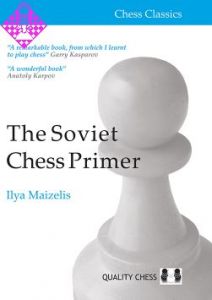 The Soviet Chess Primer (hc)24,95 €
The Soviet Chess Primer (hc)24,95 € -
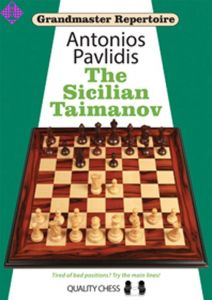 The Sicilian Taimanov27,99 €
The Sicilian Taimanov27,99 € -
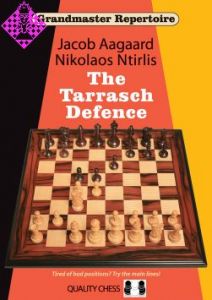 The Tarrasch Defence27,99 €
The Tarrasch Defence27,99 € -
 The Thinkers39,99 €
The Thinkers39,99 € -
 The Woodpecker Method 2 (hc)34,99 €
The Woodpecker Method 2 (hc)34,99 € -
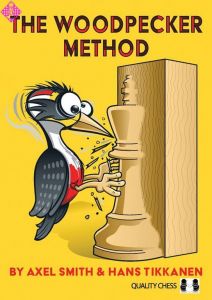 The Woodpecker Method (hc)32,50 €
The Woodpecker Method (hc)32,50 € -
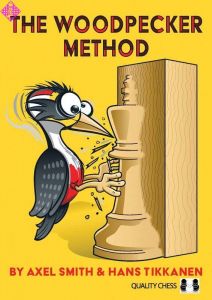 The Woodpecker Method (pb)27,99 €
The Woodpecker Method (pb)27,99 € - Mehr von Quality

